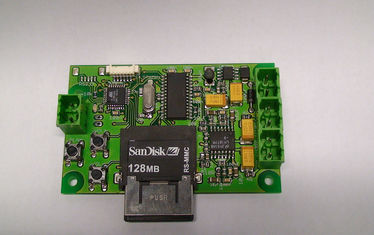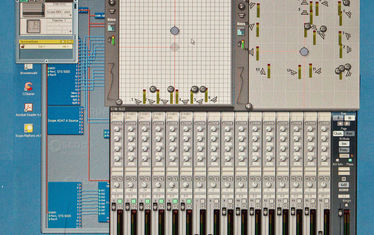Sound System
...we like the sound of that!
At the Miniatur Wunderland we primarily appeal to the sense of vision. But many scenes - think lift offs at the airport - seem all the more real when they are acoustically illustrated.
It is not precisely easy to transfer the sound of the original model onto the miniature version. Many different sounds are used in different places at the Wunderland. This is why we had to develop a different system for our fire trucks than the one we use for the concert of DJ Bobo or at the airport. Altogether we use four different sound systems and are in the process of developing a fifth.
System 1: The Beginnings
For moving objects with a relatively small activity range, we use a special type of mp3 player that is positioned in fixed places under the layout. We developed these players to be connected directly to our Light Control System. Each one can play up to 99 different sounds.
A little amp is integrated into their circuit board, making it possible to drive two speakers. Since the sound data is being read from the memory card, it is possible to change the input without removing the player. With this device several little scenes are equipped with the right sound.
System 2: Soundmatrix
With the Carsystem and ships we asked ourselves how we could equip these relatively small objects with sound. In the vehicles there was no space, because they literally were already filled to the brim with batteries and micro controllers.
So we had to find a different solution. For the Knuffingen Fire Department, it was not such a big problem, because the vehicles, built after Hamburg originals, only turned their sirens on when they came to a crossing. Here we could use mp3 players that were permanently installed under the crossings and were operated by our Carsystem controls.
For the American fire truck it was a completely different story: They drive around with ongoing sound from their sirens and even play different tunes. Since the vehicles move all through the layout, we couldn’t work with static mp3 players, because these can’t convey the image of the sound really moving with the vehicle.
After quite a search and getting in touch with several producers of audio equipment, we finally found a computer-based solution that makes it possible to “follow” the cars. The system is based on special sound cards, which are normally used in professional music and recording studios. These sound cards have up to 64 outputs of whom each can output an individual sound channel.
Of course you can’t really “follow” the cars just with this. In order to create authentic sound you have to mix the vehicles' sound, depending on their position on the layout, with different sound levels for an individual mix for each output channel. The cars don’t always take the same route, sometimes they have to stop or take a diversion, so we could not employ permanently programmed sound schedules.
A small software development team from Berlin helped us solve this problem with an amazing tool: It makes it possible to acoustically position different objects within a space, equivalent to Dolby Surround systems in cinemas, and to change these positions live and in real time as needed. With the help of the data submitted by the Carsystem control software, every vehicle on the layout can be sonically located and supplied with a large number of sounds, which can all virtually move over the layout and follow their vehicle. Another advantage of this system is that you can spread sound all over the exhibition. So far, we have chosen not to do so, since we have found out that our visitors mostly perceive sounds as a disturbance when they can’t be linked to a visually recognizable object causing them.
System 3: Airplanes
Of course we wanted to have authentic turbine sound for the airplanes at Knuffingen Airport as well, so a new system was specifically developed for the airport. The size of the models and the performance of their batteries made integrating loudspeakers into the model much easier, especially in comparison to the increasingly smaller vehicles of the Carsystem. Nevertheless we wanted to keep the audio players as small as possible, which is why we integrated them directly into the control circuit boards of the planes.
System 4: „Sounds of the future"
This is momentarily (May 2015) a prototype, being part of the MiWuLight light control circuit boards currently in development. On these circuit boards, the audio player will already be integrated.


